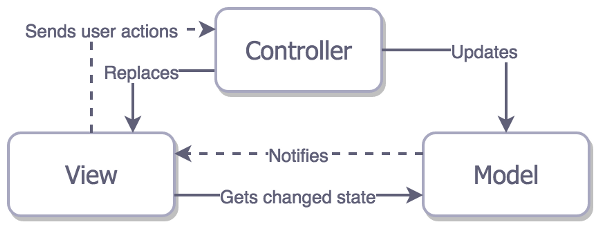#import "DataModel.h"
#import "Recipe.h"
static NSString* const FAVORITES_KEY = @"Favorites2";
NSString* const RecipesChangedNotification = @"Smoothies-RecipesChanged";
NSString* const FavoritesChangedNotification = @"Smoothies-FavoritesChanged";
@interface DataModel ()
// The list of Recipe objects
@property (nonatomic, retain) NSMutableArray* recipes;
// The list of favorite Recipe objects
@property (nonatomic, retain) NSMutableArray* favorites;
// We re-declare the property here to make it read-write instead of read-only
@property (nonatomic, retain) NSArray* sortedFavorites;
- (void)loadRecipes;
- (Recipe*)findRecipeWithId:(int)recipeId;
- (void)loadFavorites;
- (void)saveFavorites;
@end
@implementation DataModel
@synthesize recipes, favorites, sortedFavorites;
- (id)init
{
if ((self = [super init]))
{
[self loadRecipes];
[self loadFavorites];
}
return self;
}
- (void)dealloc
{
[recipes release];
[favorites release];
[sortedFavorites release];
[super dealloc];
}
- (void)loadRecipes
{
// Create the recipe list object
recipes = [[NSMutableArray arrayWithCapacity:10] retain];
// And add a few recipes to it
Recipe* recipe = [[Recipe alloc] init];
recipe.recipeId = 1;
recipe.name = @"Banana Shake";
recipe.instructions = @"1 frozen bananan1 fresh bananandollop of coconut milknhalf a glass of waternoptional: pinch of vanilla";
recipe.image = [UIImage imageNamed:@"Banana Shake.png"];
[recipes addObject:recipe];
[recipe release];
recipe = [[Recipe alloc] init];
recipe.recipeId = 2;
recipe.name = @"Green Smoothie";
recipe.instructions = @"2 bananasnhalf a glass of orange juicenhandful of fresh spinach";
recipe.image = [UIImage imageNamed:@"Green Smoothie.png"];
[recipes addObject:recipe];
[recipe release];
recipe = [[Recipe alloc] init];
recipe.recipeId = 3;
recipe.name = @"Raspberry-Blueberry";
recipe.instructions = @"1 bananan125 gr frozen raspberriesn125 gr frozen blueberriesn1 glass soy milknhalf a glass of water";
recipe.image = [UIImage imageNamed:@"Raspberry-Blueberry.png"];
[recipes addObject:recipe];
[recipe release];
// When the user adds a new recipe, this is the ID it will get. It is
// hardcoded here, but if we were actually loading the recipes from a
// file, we would determine what the highest recipeId was and then set
// nextId one higher.
nextId = 4;
}
- (int)recipeCount
{
return self.recipes.count;
}
- (Recipe*)recipeAtIndex:(int)index
{
return [self.recipes objectAtIndex:index];
}
- (void)addRecipe:(Recipe*)recipe
{
recipe.recipeId = nextId++;
[self.recipes addObject:recipe];
}
- (void)removeRecipeAtIndex:(int)index
{
// Also remove the recipe from the list of favorites
Recipe* recipe = [self recipeAtIndex:index];
[self removeFromFavorites:recipe];
[self.recipes removeObjectAtIndex:index];
}
- (void)didChangeRecipe:(Recipe*)recipe
{
[[NSNotificationCenter defaultCenter] postNotificationName:RecipesChangedNotification object:self];
// If the name of the recipe was changed, the sort order of the favorites
// list may be wrong, so we reload the list of favorites as well.
self.sortedFavorites = nil;
[[NSNotificationCenter defaultCenter] postNotificationName:FavoritesChangedNotification object:self];
}
- (Recipe*)findRecipeWithId:(int)recipeId
{
for (Recipe* recipe in self.recipes)
{
if (recipe.recipeId == recipeId)
return recipe;
}
return nil;
}
- (void)loadFavorites
{
// Create the favorites list object
NSArray* array = [[NSUserDefaults standardUserDefaults] objectForKey:FAVORITES_KEY];
self.favorites = [NSMutableArray arrayWithCapacity:array.count];
for (NSNumber* number in array)
{
int recipeId = [number intValue];
if ([self findRecipeWithId:recipeId] != nil)
[self.favorites addObject:number];
}
}
- (void)saveFavorites
{
[[NSUserDefaults standardUserDefaults] setObject:self.favorites forKey:FAVORITES_KEY];
[[NSUserDefaults standardUserDefaults] synchronize];
}
- (int)favoritesCount
{
return self.sortedFavorites.count;
}
- (NSArray*)sortedFavorites
{
if (sortedFavorites == nil) // lazy loading
{
// Add the Recipe objects to a new list
self.sortedFavorites = [NSMutableArray arrayWithCapacity:favorites.count];
for (NSNumber* number in self.favorites)
{
int recipeId = [number intValue];
Recipe* recipe = [self findRecipeWithId:recipeId];
if (recipe != nil)
{
[sortedFavorites addObject:recipe];
}
}
// Sort the list by last name
[sortedFavorites sortUsingSelector:@selector(compareName:)];
}
return sortedFavorites;
}
- (BOOL)isFavorite:(Recipe*)recipe
{
return [self.favorites containsObject:[NSNumber numberWithInt:recipe.recipeId]];
}
- (void)addToFavorites:(Recipe*)recipe
{
// Add the recipe's ID to the favorites list
[self.favorites addObject:[NSNumber numberWithInt:recipe.recipeId]];
// Save the favorites to NSUserDefaults
[self saveFavorites];
// We release the old sorted list and set it to nil. The next time anyone
// asks for it, it will be re-created from scratch.
self.sortedFavorites = nil;
// Let any listeners know the list of favorites has changed
[[NSNotificationCenter defaultCenter] postNotificationName:FavoritesChangedNotification object:self];
}
- (void)removeFromFavorites:(Recipe*)recipe
{
[self.favorites removeObject:[NSNumber numberWithInt:recipe.recipeId]];
[self saveFavorites];
self.sortedFavorites = nil;
[[NSNotificationCenter defaultCenter] postNotificationName:FavoritesChangedNotification object:self];
}
@end
